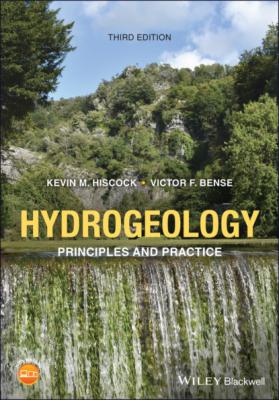ТОП просматриваемых книг сайта:
Hydrogeology. Kevin M. Hiscock
Читать онлайн.Название Hydrogeology
Год выпуска 0
isbn 9781119569510
Автор произведения Kevin M. Hiscock
Жанр Биология
Издательство John Wiley & Sons Limited
Table 1.5 Estimated abstractions from all surface water and groundwater in England by purpose and Environment Agency region for 2017. All data are given as 106 m3.
| Region | Domestic usea | Spray irrigation | Agricultureb | Industryc | Total | |||||
|---|---|---|---|---|---|---|---|---|---|---|
| Surface water | Groundwater | Surface water | Groundwater | Surface water | Groundwater | Surface water | Groundwater | Surface water | Groundwater | |
| England | 3661 | 1669 | 46 | 41 | 770 | 140 | 3873 | 195 | 8350 | 2044 |
| North West | 624 | 65 | 0 | 1 | 13 | 3 | 863 | 23 | 1501 | 92 |
| North East | 640 | 104 | 1 | 3 | 65 | 24 | 1126 | 21 | 1834 | 153 |
| Midlands | 585 | 280 | 9 | 7 | 12 | 2 | 814 | 38 | 1429 | 327 |
| Anglian | 484 | 269 | 29 | 24 | 19 | 3 | 145 | 35 | 680 | 332 |
| Thames | 918 | 482 | 1 | 3 | 54 | 10 | 286 | 27 | 1262 | 523 |
| Southern | 112 | 341 | 4 | 2 | 257 | 47 | 23 | 32 | 397 | 421 |
| South West | 297 | 127 | 0 | 1 | 350 | 51 | 600 | 19 | 1248 | 197 |
a Category includes public and private water supplies.
b Category includes fish farming, cress growing and amenity ponds. Excludes spray irrigation.
c Category includes electricity supply and other industries.
The Water Resources Act 1963 led to the formation of 27 catchment‐based authorities responsible for pollution prevention, fisheries, land drainage and water resources. The Act ushered in a decade of groundwater resources management that required the licensing of all abstractions in England and Wales. Under Section 14 of the Act, each authority was required to undertake a survey of resources and the Water Resources Board (abolished 1974) was established with the task of resource planning on a national scale. Regional groundwater schemes were developed in the context of river basin analysis for the purposes of river augmentation by groundwater, seasonal abstraction and artificial recharge. Scientific advancement in the application of numerical models to solve non‐linear equations of groundwater flow permitted the prediction of future groundwater abstraction regimes.
The Water Act 1973 reflected the importance of water quality aspects and heralded the developing interest in groundwater quality. The Act led to the formation of 10 catchment‐based regional water authorities with responsibility for all water and sewerage services and for all parts of the water cycle. The Control of Pollution Act 1974 extended the powers of the regional water authorities in controlling effluent discharge to underground strata and limited certain activities that could lead to polluting discharges. The first aquifer protection policies were developed at this time.
The Water Act 1989 separated the water supply and regulatory functions of the regional water authorities, and the new National Rivers Authority was set‐up to manage water resources planning, abstraction control, pollution prevention and aquifer protection. A number of other Acts of Parliament followed including the Environmental Protection Act 1990 and the Water Resources Act 1991 that control the direct and indirect discharge of harmful substances into groundwater and are, in part, an enactment of the European Communities Directive on the Protection of Groundwater Against Certain Dangerous Substances (80/68/EEC). Further controls on discharges were implemented under the Groundwater Regulations 1998. In addition, the Water Resources Act 1991 consolidated all the provisions of the Water Resources Act 1963 in respect of the control of groundwater abstractions. In pursuing a strategy to protect both individual borehole sources and wider groundwater resources, the National Rivers Authority (1992) developed its practice and policy for the protection of groundwater with the aim of raising awareness of the vulnerability of groundwater to surface‐derived pollution. Following the establishment of the Environment Agency under the Environment Act 1995 (when the National Rivers Authority, Her Majesty's Inspectorate of Pollution and the Waste Regulatory Authorities were brought together) the practice and policy document for the protection of groundwater was updated (Environment Agency 1998).
Currently, the Environment Agency for England and Wales promotes a national framework for water resources protection in the context of existing European initiatives, principally the Water Framework Directive (Section

